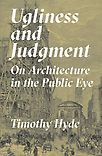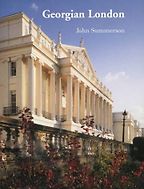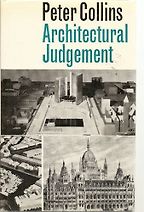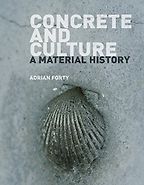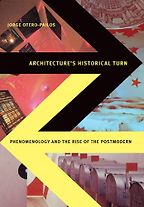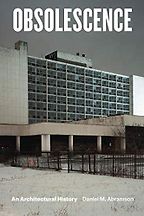Before we discuss your books, I wanted to ask: what do we mean when we talk about the aesthetics of architecture?
What I mean is the appearance of architecture, and that includes prominently the visual appearance of architecture—outward and inward, the outside and inside. But it also includes the sensorial experience of architecture. It’s acoustics, it’s tactility, it’s the idea that architecture has a physical presence, whether in a design where it’s an anticipated physical presence or an actualized building where it’s a real presence. When I talk about the aesthetics of architecture, I’m talking about that dimension.
This would be distinct, for example, from approaching architecture from the point of view of programme or function. How is architecture used? How does it fulfil its use? Or approaching architecture from the point of view of technology: using a scientific approach, analysing its structure, its environmental performance, the source and the consequences of its materials, for example. I would contrast the aesthetic against those other approaches and say, really, I’m talking about it straightforwardly as the appearance of architecture, prominently visual appearance, but also potentially including other sensorial aspects.
In your recent book Ugliness and Judgment: On Architecture in the Public Eye, you argue that aesthetic questions relating to architecture perform a vital function in civil society. They are a way of effectively arbitrating or at least expressing notions of how we want our society to be. Architecture is necessarily implicated in questions of social organisation and politics because it’s a shared space.
Yes. I think that we could begin by just asking the question of how much the aesthetics of architecture matter today when we’re confronted with a series of societal challenges, whether it’s the crisis of climate change, social inequities and the housing burden, regulatory failures and so on.
Perhaps the aesthetics of architecture are a luxury in terms of debate and argumentation and interpretation. What I’m interested in—specifically in the book, Ugliness and Judgment—is whether the aesthetics of architecture do matter, not so much in terms of individual taste or discrimination or experiential response of a given person who encounters a building, but whether they matter deeply in a more oblique way. Aesthetics of architecture actually do have an influence upon formulating social programmes and social institutions—what I refer to as social techniques or social technologies—which are things like laws and policies or customs and behaviours.
Get the weekly Five Books newsletter
In my book, I’m trying to look at ugliness specifically as a kind of aesthetic judgement that very often signals a moment of political, social or economic conflict; or controversy; or difficulty. Then, that same judgment of ugliness allows or prompts architecture to actually participate in parallel or adjacent kinds of social mediums, like law, science, or religion. In these kinds of debates, we can actually see the aesthetics of architecture having a very strong instrumental social consequence, just not in the way we conventionally think of it—of the building standing in the street and being observed by a person. Rather, they are consequential in the fact that architectural thinking is migrated into some other domain of social endeavour.
I suppose it becomes tied up with questions of urban planning, social policy. In its myriad forms, it becomes a prism for looking at the configuration of a particular society.
That’s right. All these things are interlaced. Architecture obviously is a practice, and then a set of objects that draw upon science and technology, customs and behaviours and social norms and that draw upon intellectual labour as well as physical labour. These represent enormous investments of social energy. Architecture is inevitably linked to these other kinds of thinking, these other modes of practice, these modes of doing. Also, over the course of the last few hundred years, it’s become increasingly evident that the individual building can never really be an individual building. It’s always a connection to a larger context. Even a building in a rural environment is connected to a much larger built and cultural environment. We can no longer think of architecture in the classical sense of merely the design of a building. An architect is really designing a process that is interlaced with other processes.
Is there be a parallel to be made with recent approaches to social history, introducing more anthropological elements in history? Throughout history, buildings have been built, sponsored, financed, inhabited, and used, generating an architectural discourse that goes right back to the earliest constructions of mankind.
Architecture is indeed a social endeavour in that sense and related to these other processes. In fact, social histories of architecture have become more common in recent decades, but they’ve existed for a while now in parallel to what we might call more disciplinary histories that are looking either monographically at an architect or that are following a certain period of building, Renaissance architecture, for example. The social histories of architecture are there, and they’ve drawn very strongly on social and cultural histories and material history in parallel fields and in history proper.
“Window details are much more a result of a decision based upon building regulation and concern for the spread of fire than they are the result of an isolated artistic aesthetic decision.”
What I believe hasn’t been dealt with fully is the aesthetic dimension of architecture in those social histories. In the discipline of architectural history, there is a bit of a false schism. Either one is engaged in social history, or one is engaged in a formal history that takes into account aesthetics as an instrumental force. I’m really interested in trying to bring those two paths together to understand how the aesthetic operates socially as opposed to seeing the aesthetic as something that is only an interaction with an individual person in the world; that it actually is a collective response, not merely an individual response. We are talking about collective aesthetic judgments, and these do have a social instrumentality, just in a mediated or oblique way, as architecture winds through different social processes.
To a large degree, form and function become interlinked in the public debate. These days, for example, a building’s sustainability credentials might feature in an assessment of its worthiness and therefore its aesthetic qualities as well.
We could think of this in terms of the possibility that the aesthetic is a kind of luxury. Because today we might say, “Well, I’m not concerned with whether I like or dislike the building’s aesthetic appearance, because I know that it has an extraordinarily high performance in environmental terms, that it is a sustainable building and therefore an ethical building. I will set aside, then, its aesthetic judgement. I will suspend judgement on its aesthetic qualities because I’m giving priority to this other dimension.” We could think of that in economic terms as well: a very cheap building, for example, may be exempted from aesthetic considerations or have these as subordinate features in favour of other social priorities. It may need to be cheap, if there’s a social benefit to its cheapness.
Let’s begin with Georgian London by John Summerson. Aesthetically, this is an architectural period that is held in high esteem. For many conservationists in debates that you describe in your book, many buildings from this period are held up as a paragon of style, or a recent iteration of classical paragons of style. Tell me a little bit about how this book influenced your work.
In the selection of these five books, I’ve been conscious of each of them giving us a way to potentially think about a style of architecture. We’ll begin with the Georgian, but we’ll see as we go along that each one has a particular lens that it offers on a known style of architecture. I’m doing this actually not to undermine, but to make more expansive, our understanding of style and the way we think about it. I do believe that the notion of style or the category of style has been the approach that architectural history and the lay public has used in order to make aesthetic determinations. When we discuss the aesthetics of architecture—this appearance of architecture that I’m talking about—in public debate, we tend see it through the lens of style.
This actually constrains what we’re able to see and the way in which we’re able to think about the aesthetic dimension of architecture. These five books offer a different lens on aesthetics and architecture precisely because they might give us a slightly different perspective on the notion of style. What’s important about Georgian London and important for me as a historian is that this was a book that really opened architecture to a social and economic history when it was published in 1948.
Although the book is called Georgian London, and Summerson is very clear and very specific about the formal characteristics of Georgian London—the window details, the cornice lines, the types of streets, the scale of streets—he then explains the ways in which these different aesthetic dimensions of architecture actually had their origins in social and economic determinations or calculations, either economic necessity or social desirability, reflecting things like the fire codes that resulted from the building act after the Great Fire of 1666.
He points to the fact that, for example, window details are much more a result of a decision based upon building regulation and concern for the spread of fire than they are the result of an isolated, artistic aesthetic decision. Summerson lets us see the city now and the way it develops over time, yes, as an emergence of a style, but he binds that together, making it inseparable from the social and economic dimensions of architecture. That’s the real strength of the work, and its continued influence over time. This was written just after World War II and really opened up a different kind of architectural history following its publication, and its many republications and subsequent additions.
I enjoyed imagining the organic development of London as a result of trade cycles and periods of peace and war. In this book, one gets a very rich glimpse of the long 18th century, 1660–1830. Moreover, our guide is the very picture of a gentleman architect, with a simply wonderful turn of phrase. I suppose one would expect nothing less from somebody who was both a curator and lived in the Sir John Soane Museum, one of London’s architectural gems.
It’s a very elegantly written book, with a masterful use of both metaphor and positioning to allow a reader to really see these otherwise invisible aspects of the city, its economic development.
The book begins by asking the reader to take an aerial view. This is, of course, the time of World War II, when aerial views of city are just actually becoming something that public can imagine for the first time. Summerson presents this aerial view as a kind of accelerated film where you could see the city expand and grow and change as it takes shape during the Georgian period.
He’s really using writing to project very strongly a visual understanding of architecture. Summerson includes illustrations, but those are more sparse given the publication constraints at the time. He’s really relying on the text, the language, to convey a visual understanding of architecture and the city, while at the same time giving you a sense of its mercantile activity—the decisions that are being made by an individual land speculator, by an architect, or by a sponsor for one or other social reasons or economic reasons.
The conceptual tools used by the writers in your selection I feel really reflect their personalities to a large degree. Let’s take your next book, Architectural Judgement by Peter Collins. Here’s somebody who by contrast seems almost obsessed with questions of precedent, techniques that he borrowed from the legal profession in order to make architectural assessments.
This is a strange book, but a very interesting one and I think an important one. It’s not widely read compared to other books of his like Changing Ideals in Modern Architecture. This lesser-known work I think reflects a kind of crisis in his own thinking. He’s asking, what is the basis of our actual judgement? How do we make aesthetic judgements about architecture and other kinds of judgements about architecture? It followed from a year he spent on sabbatical at Yale Law School. He was an architectural historian at the University of McGill in Canada, and he went to Yale Law School for a year to take classes and consider legal thought. He felt that perhaps this would be the other profession with a highly developed sense of rational judgement and that by placing legal judgement and architectural judgement in parallel, he could discern the possibility of new principles of architectural judgement.
“If architecture cannot resolve its own means of judgement in a more transparent and direct way, then it will find itself in an increasingly difficult position in relationship to public opinion.”
Collins is really trying to decipher high modernism of the 1950s and 60s to understand how architecture might be viewed according to criteria other than functionalist. He’s looking at architecture that at that moment is explaining itself, legitimating itself in terms of functionalism and its ability to resolve a given function. In the book, Collins is arguing that we know that there are these other dimensions being considered, like the cost of a building, its structural efficiencies, and also its aesthetic qualities. He wants to know how architecture could begin to have rational qualities or rational principles for those dimensions as well. What he finds is a sense that architecture has experienced a schism between its rational principles, which are to do with function, and its irrational desires, which are to do with the aesthetic.
He is also very concerned with the ability of architecture to present its judgments to the public, to be able to defend itself in a sense against public criticism or public judgments. This is also a moment when the critique of modernism is really beginning to emerge in force and people are beginning to describe high modernist buildings in negative terms and resist the introduction of new modernist civic buildings into city fabric. The preservation moment is just beginning around this time, as well. I think that Collins had a sense of anxiety. If architecture cannot resolve its own means of judgement in a more transparent and direct way, then it will find itself in an increasingly difficult position in relation to public opinion.
The law profession would seem to be a natural place for one to look for an overarching authority that would be able to impose structure on these debates.
It’s a natural place to look, certainly, because the legal profession announces its terms of judgement as it goes along. Every step of the legal process is an enunciation of a decision, a judgement or rationale, whether it’s the stipulation of a fact or the rendering of a decision. It’s about a kind of transparency of judgement. I think Collins actually found some difficulties in making the parallel, because he sees great differences as well between architectural and legal judgement. The understanding and use of historical precedent are certainly prominent among them. He is very interested in the way law uses precedent, and this is one of the reasons why he enters into law in the first place. He then discovers however that there are differences in legal approaches to history and architectural approaches to history, where law is really concerned with the instrumentality of a precedent.
If a precedent is binding—if it still has some pertinence to a contemporary case—then it is still part of the law. If a precedent is not binding, if it does not have pertinence to a contemporary case, then it’s simply called history, and it really doesn’t have any presence any longer in the law. It’s simply an interesting fact from the past. This doesn’t translate for Collins directly to architecture, because he wants to think about how architecture can draw forms forward and use those precedents rationally, to legitimate a certain moment in the present. There, he obviously runs against the enormous functional changes that have occurred in architecture, as opposed to the aesthetic changes, which are maybe not so profound or so pronounced as the more technical aspects.
What would Collins make of today’s ‘starchitect’ culture, in your view? Where it often seems that the aesthetic objective is to create something without precedent, one-off buildings that that stand almost as works of art or abstract sculpture. Perhaps these become the kind of historic episodes you describe, that are left behind and become in his view, at least, a sort of irrelevant from the perspective of creating something that creates a precedent.
Collins has a similar standpoint to Summerson: that the aesthetic dimension of architecture is really bound up or rooted within a broader social contextual setting, and that the isolated architectural object (or the object that seeks to free itself from any context and present itself as a kind of pure aesthetic object) has, I think in Collins’s view, drawn too much upon a kind of avant-garde art discourse ill-suited to the very different discipline of architecture. I think he would resist the ‘starchitect’ culture on those grounds.
“So concrete cannot mean one thing; the concept of concrete unfolds in different ways precisely because it is also an economic instrument.”
Even more so, he might resist it on professional as opposed to theoretical grounds. There’s a sense you get from this book that Collins is interested in the architectural professional being a good judge, an honest professional and practitioner not consumed with attracting attention to him or herself, indeed not even with attracting a great deal of attention to the building. Collins is asking for a slightly more restrained practice in a way, a more professional profession. He thinks that these principles, if they could be established, would actually be the basis for solidifying the reasonability of the profession.
Let’s talk about Concrete. This is the material of high modernism, used ubiquitously in modern infrastructure and architecture, and in many ways exemplifying the rationality of our technologically driven culture.
Adrian Forty’s book we could put alongside the style of Brutalism for a start. This style has represented recently the strongest challenge to an aesthetic norm or to people’s aesthetic sensibilities. When you raise the topic of aesthetics and architecture, very often Brutalism is the architecture that comes into discussion. It has such a strong aesthetic presence, yet seems to be one that is so antagonistic to the persons or the society that it is addressing. What Adrian Forty, a brilliant contemporary architectural historian, is trying to write here is what he calls the history of concrete as a medium of culture. He’s interested in concrete as the technical material of course, but there are other books that have dealt with that aspect. He’s interested in concrete as a signifier of a certain kind of style, but here again, there are other books that also look at Brutalism specifically. More than anything, what he’s really interested in is the way concrete has been used as a kind of medium for cultural expression, for what he also calls iconography cultures.
“When you raise the topic of aesthetics and architecture, very often Brutalism is the style that comes into discussion.”
Forty argues that concrete is really the modern material that has been affiliated with modern architecture since its inception, and that has unfolded with the different stages of modernism over the course of the 20th century. It’s a material that becomes representative of modernization, the building of dams, for example, or large-scale building projects in developing societies. He’s looking therefore at concrete in a multifaceted way, inquiring into its many dimensions. What is the actual texture of concrete? How is it manufactured? What are key aspects of its finishing, its form, its shaping, and of course its durability? That is, both its physical presence and the way in which it lasts, but also conversely its weathering and the way in which it decays. It has a particular kind of characteristic expression as well. And the question around concrete and its carbon footprint has unfolded really in the last few years very strongly.
Forty’s book is interesting, and I think crucial because it allows us to approach the aesthetic question from a different angle, through material and the material expression of architecture. It allows us to understand that a given material, even if it is affiliated very strongly with Brutalism for example, has actually had many different appearances in different social settings.
In some cases, the aesthetic appearance of a concrete building is one of refinement, precision, and high skill. In another social setting, the aesthetic appearance is one of crudeness, unskilled labour or construction, for example. What this reveals to us very strongly is the way in which the aesthetic appearance is again absolutely inseparable from a kind of social and economic context within which it is bound up. So concrete cannot mean one thing; the concept of concrete unfolds in different ways precisely because it is also an economic instrument. It’s an economic decision to build with concrete, whether it means making a decision that’s quite costly or quite cheap, depending on how the material is deployed.
By thinking about concrete in this different way, writing an architectural history of concrete as opposed to an architectural history of Brutalism, I think Forty is able to give us a different way of thinking about our encounter with the aesthetic. Rather than prompting us to ask directly, “What was the architect thinking in using the concrete?”, we are prompted instead to ask what does the concrete mean in the given setting that I inhabit when I encounter that building? What did the concrete mean in a given setting when that building was constructed, and what does it mean 30 years later, 50 years later, 70 years later? It gives us a sense of the temporality of the aesthetics of architecture more strongly and differently, I think, than do Summerson or Collins.
The way that the term ‘Brutalism’ came about itself denotes this shift from thinking of it simply as a material, ‘beton brut’ or raw concrete, to thinking about moral and social associations to do with a style’s perceived brutality or inhospitable nature. The way that the term carried over somewhat awkwardly from the French into the English shows how laden architectural terms can become.
One of the things signalled there is uncertainty about whether the aesthetic aspect of architecture is something designed, or something discovered. The idea of many Brutalist architects was to present materials to a viewer in unadulterated form, to concede in a sense that these materials do indeed have an aesthetic appearance, but one that is not a designed appearance. This is very different from earlier expressions of concrete, where concrete was being put forward precisely because of its ‘designability’. It could be shaped into forms because its surface was not a natural surface, but a surface that was actually crafted, either made smooth or made rough in a very deliberate fashion. So, you have a contradiction embedded in the use of concrete in architecture, a contradiction over whether the aesthetic expression is one that is designed intentionally or one that is simply discovered and presented.
Let’s move from a discussion of materiality and modernism to a postmodern moment, where architects or architectural theorists began to address the experience of architectural. In Architecture’s Historic Turn, Jorge Otero-Pailos talks about the phenomenology of architecture. Phenomenology—is this just a fancy word for lived experience?
I think that’s initially how Jorge Otero-Pailos intends it to be understood, as the lived experience of a person in relation to a building. The cast of characters that he’s looking at—the well-known postmodern architect Charles Moore, the architect and theorist Christian Norberg-Schulz, and others—are then trying to draw the association between lived experience and a cognitive conception; that is, some sort of intellectual understanding that arises out of lived experience. In some cases, that’s a kind of sensorial experience, but it can also be a sense of judgement based upon other inputs. These protagonists do again strongly prioritise the visual communication that is enabled through lived experience. But Otero-Pailos’ approach does also allow for the other sensorial dimensions of experience as well.
This book gives us a way, I think, to think about modernism’s successor, postmodernism and postmodern architecture, in a broader and more complex way. Postmodern architecture as a style most often is reduced to historicist elements, so an architecture that depends upon and puts forward imitative forms of historical, largely neoclassical architecture. It also encompasses other forms of revivals, of historic forms of architecture, and assembles those into visual codes. These can be humorous and ironic, but they can also be very serious. Typically, these are visual codes that attempt to establish continuity with past modes of architectural expression.
What this book says is that we shouldn’t think initially about historicist postmodernism. Rather, we should think about the fact that these architects were trying to understand physical experience, bodily experience, lived experience in relationship to architecture. This is a way to establish historical continuity—to see that the new forms of architecture in a contemporary moment could be drawing upon aesthetic experiences that were consistent over long historical spans of time.
“Postmodern architecture as a style most often is reduced to historicist elements, so an architecture that depends upon and puts forward imitative forms of historical, largely neoclassical architecture.”
According to Otero-Pailos, several of these architects argued that there were essential human experiences constructed by architecture, giving a particular sense of enclosure or movement, for example, and that these could be recapitulated over time in varying forms. So the buildings didn’t have to simply, literally repeat over a historical span. But then, an architect in 1960 and 1970 could be attempting to produce a sense of enclosure that echoed the work of an architect of the 18th or 17th century, precisely because both of them were trying to reflect an essential lived experience that was common over time and that we all share, even in different time periods.
In pursuing this aim, these architects do emphasise the visual dimension of architecture. An architect may reproduce a lived experience, but the encounter with architecture is predominantly a visual one: what is designed, sculpted, shaped is movement, light, the unfolding of surfaces, and then, at a smaller scale, the play of visual codes of ornamentation across surfaces, to be interpreted not through a kind of abstract rationality, but rather by an actual person physically present in an encounter with the architecture
All of which points to the multiplicity of our inheritance in contemporary architectural practice, and perhaps also the way in which styles go out of fashion. Obsolescence, the last book on your list, talks about buildings being deemed dysfunctional after a certain time. This may have been an intellectual fabrication devised by Chicago developers simply to make more money, but it’s proved to be a very durable concept when we think about both architectural styles and also architectural function. There’s a ceaseless striving for the new.
The argument that Daniel Abramson makes is that obsolescence is an economic instrument which has been alongside modernism throughout its history, just like concrete has been modernism’s material companion. Obsolescence is also an economic process connected to the aesthetic. One of the major contributions of his book is the way it connects the aesthetic dimension of architecture to an economic dimension. They co-originate in late 19th century Chicago and move forward in and through the unfolding of various different modernist styles. The book shows the relationship between obsolescence as a concept and architectural styles like Brutalism or postmodernism and high modernism as well as high-tech architecture, which is another style of architecture that we might be familiar with, as it’s often used to approach architectural appearance in the contemporary moment.
Abramson stitches together that kind of longer narrative to show the way in which architecture in the 20th century is very often either trying to develop a certain obedience to principles or processes of obsolescence or trying to develop means of resisting that process of obsolescence. Brutalism, for example, might be an architectural style whose physical presence is a resistance to obsolescence, but whose aesthetic appearance is also trying to announce a resistance to obsolescence, trying to present a sense of solidity, durability.
“Both ugliness and obsolescence become a space of transaction between architecture and society.”
Then postmodernism, in spite of its often flimsy materiality, is also announcing a kind of resistance to the idea of obsolescence by saying that there are historical continuities, that there are unchanging essential historical constants in the appearance of architecture and that these will be continued into the future, that these will not become obsolete at any given time. Abramson asks his reader to think in more complex way about the motivation of a given aesthetic approach within architecture. In his work, the aesthetic approach is not just an experiential encounter with the building. He’s thinking about the way in which judgements and assessments and decisions about materials are being combined with decisions about form and formal arrangements.
Those two elements are being combined with an idea, either of the indeterminacy of a given programme—the fact that it will change over time—or the certainty of a given programme—the fact that it must be maintained over time—so that we can see therein the aesthetic dimension of architecture being embedded with technological decisions. Take, for example, the creation of open plan offices, or of different kinds of exterior envelopes for buildings, facades and so on. Where these are aesthetic choices, they are being, in a sense, determined or contrived (or at the very least influenced) by a decision to interact with the process of obsolescence in some way. It may be to resist it. It may be to fulfil it. But either way, they are contingencies of an encompassing cultural model of obsolescence.
I felt there was a parallel to be made between the way Abramson treats obsolescence and the way that you discuss ugliness in architectural discourse. Both notions—pronouncements of ugliness, pronouncements of obsolescence—are to an extent social and deeply politically embedded judgments that masquerade as taste or style. They actually tell us an awful lot about the sort of society that we believe we live in and the sort of society that we aspire to create.
That’s right. Both ugliness and obsolescence become a space of transaction between architecture and society. They become a way in which a social idea, whether that idea is a desire, an imperative, an overt kind of political judgement or an implicit social custom, some element of social behaviour or social technique can be entered into a transaction with architectural thinking. That transaction goes in both directions, so that there are times when architectural thinking is able to modify a social technique. I think in the case of obsolescence, what Abramson demonstrates is the way in which architectural representations or manifestations of obsolescence do affect the way that society at large then engages with and approaches that obsolescence. This is certainly the case with the rise of the preservation movement, for example, which is driven in part by a very public, visible, and visceral experience of obsolescence, of decay, and also of demolition. It is often a reaction to demolition that leads to social debate and decisions about preservation and adaptive reuse.
In my book as well, preservation has a role to play. There are arguments that unfold about preservation that hinge on questions of ugliness, incompatibility or incongruity between the old and the new. Social concern for preservation, using the word in a very simple way, really reflects a very complex sort of feeling that exchanges between architectural thinking and social thinking.
“It is often a reaction to demolition that leads to social debate and decisions about preservation and adaptive reuse.”
Preservationists are often a caricatured as simply being stuck in nostalgia, and some of them may be. But as a social practice, the preservation movement is more complicated. It is about a set of decisions that we’re making about proprieties, about social customs, not just buildings we want to preserve, but social customs we want to preserve. It also concerns making decisions about existing social customs that may be obstacles to people, and whether a certain kind of change in the aesthetic environment will open up a set of possibilities for the participation of people who are excluded from certain aspects of society. These questions around the aesthetics of architecture I think are always a proxy for other social questions, social debates. We need to open the aesthetics of architecture into that fuller debate and avoid the narrow constraint of style because it limits our ability to really see and therefore judge the transactions that are taking place, on several social, economic and political levels.
That’s what we should really be concerned about as a society. What are the transactions that are taking place and the decisions that are being made that fall to the advantage or disadvantage of different constituencies and that allow for a certain kind of potential or harm to unfold socially? If we can open the understanding of aesthetics through books like these five, and I hope through my book as well, I think we’ll have a more instrumental, more profitable understanding of the way in which architecture actually not only reflects our society but actually shapes the next stages of our society.
To bring it full circle then, questions of aesthetics are anything but an indulgence or a consumerist luxury, but on the contrary are central to having a healthy civic discourse.
I absolutely think they are central to having a healthy civic discourse, but we need new terms of debate to talk about aesthetics and to step away from a recurrence of the style wars. We need to step away from a recurrence of normative ideas of beauty, ugliness, obsolescence, or the value of concrete, the value of history and to ask the questions in a more subtle, nuanced way in order to be able to carry out the changes that as a society we want to see.
Five Books aims to keep its book recommendations and interviews up to date. If you are the interviewee and would like to update your choice of books (or even just what you say about them) please email us at [email protected]
Five Books interviews are expensive to produce. If you've enjoyed this interview, please support us by donating a small amount.

